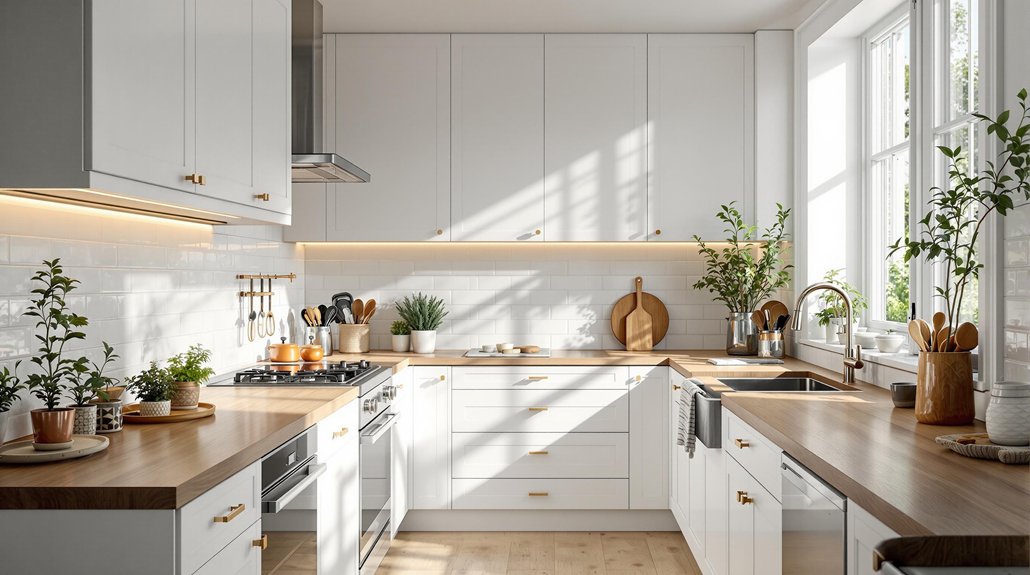
14 White Kitchen With Wooden Worktop Ideas That Are Warm and Stylish
White kitchens with wooden worktops offer crisp clarity balanced by tactile warmth, blending high-gloss or classic cabinetry with oak or walnut surfaces for enduring visual appeal. This combination enhances light, amplifies space, and showcases a harmonious contrast between smooth and organic textures. Functional layouts, such as U-shaped or compact galley designs, support efficient workflow while layered lighting highlights wood grains and display shelving. Exploring specific design pairings and expert tips reveals even more ways to enhance both style and practicality.
Key Takeaways
- Pair crisp white cabinetry with warm oak or walnut worktops to create timeless, light-filled kitchens that feel both modern and inviting.
- Incorporate open shelving in reclaimed wood for accessible storage and a touch of rustic character that complements the white and wood palette.
- Use layered lighting, such as warm pendants and under-cabinet LEDs, to highlight wood textures and enhance the kitchen’s welcoming atmosphere.
- Combine glossy white cabinets with pale butcher block counters for a visually soft, airy look ideal for compact or Scandinavian-inspired kitchens.
- Personalize the space with natural accessories and curated displays on wooden shelves to add warmth while maintaining a cohesive, serene design.
Modern Farmhouse White Kitchen With Oak Worktops
Blending classic design with contemporary function, a modern farmhouse white kitchen with oak worktops is defined by its crisp shaker-style cabinetry and the visual warmth of natural oak surfaces.
White kitchens achieve timeless appeal through the interplay of bright, reflective cabinetry and substantial wooden worktops, which introduce organic texture and inviting contrast. The hallmark apron front sink enhances task efficiency while reinforcing the farmhouse aesthetic.
Bright cabinetry pairs with rich oak worktops, creating timeless contrast and warmth at the heart of a modern farmhouse kitchen.
Open shelving, typically crafted from reclaimed wood or finished to coordinate with the oak worktops, provides practical storage and opportunities for curated display, emphasizing both accessibility and personal expression.
Industrial accents—such as matte black or brushed metal hardware and pendant lighting—add functional resilience and a subtle edge, ensuring that the space remains grounded in modern sensibilities without abandoning its rustic roots.
Additionally, natural stone backsplashes and countertops can complement the oak worktops, offering durability and a tactile quality that enhances the overall aesthetic.
Sleek Glossy Cabinets Paired With Natural Wood Surfaces
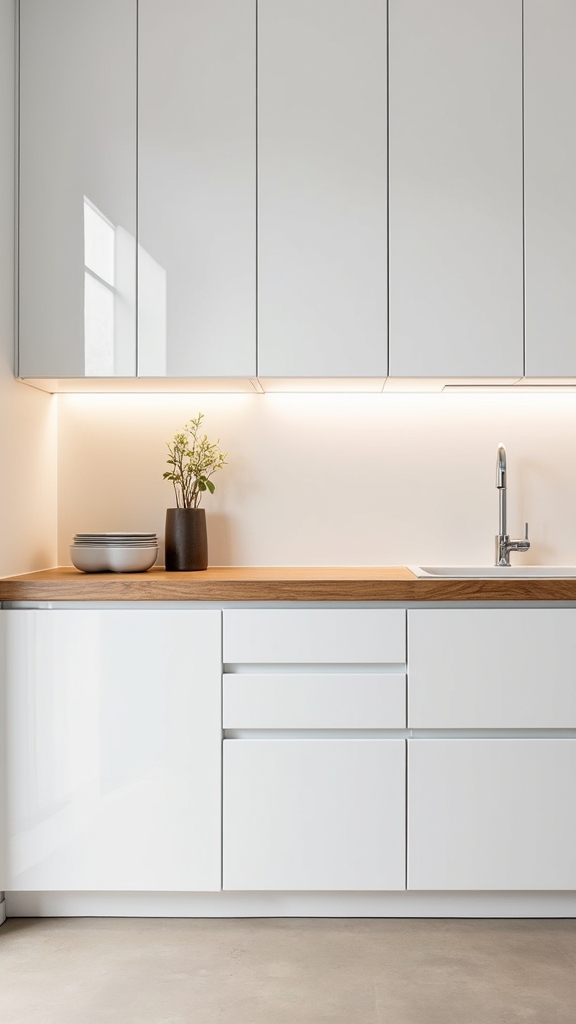
Sleek, high-gloss white cabinetry optimizes ambient light, amplifying spatial perception and visual clarity within the kitchen. By integrating natural wood surfaces, designers introduce warmth and tactile contrast, mitigating the potential sterility of modern finishes. Light wood butcher block countertops add subtle warmth to white kitchens, balancing natural beauty with modern elegance. This interplay of reflective and organic materials achieves equilibrium between contemporary brightness and inviting comfort, supporting both functional and aesthetic objectives.
Enhancing Light With Contrast
When glossy white cabinetry is paired with natural wood surfaces, the interplay of materials strategically boosts light within the kitchen, producing a brighter and more expansive environment.
The high reflectivity of white gloss finishes on cabinets increases ambient light, ideal for compact spaces where maximizing brightness is essential.
In contrast, the wooden worktop introduces tactile warmth and visual depth, offsetting the sleekness of gloss with organic texture.
This deliberate juxtaposition establishes a dynamic focal point while maintaining a harmonious visual balance.
The contrast between reflective cabinetry and matte wooden surfaces not only enhances aesthetic interest but also improves practical functionality, as wood’s durability suits daily kitchen demands.
Versatility emerges from this scheme, enabling adaptation to a wide range of interior styles and evolving design preferences.
Balancing Modern And Warmth
Glossy white cabinetry, with its high-reflective surfaces, amplifies ambient light and cultivates a streamlined, modern kitchen environment. This approach to white kitchen ideas leverages minimalism and spatial enhancement, ensuring the kitchen feels open and uncluttered.
When paired with natural wooden worktops—such as oak or walnut—the result is a dynamic interplay of tactile warmth and visual coolness. Wooden worktops introduce organic texture and subtle color variation, effectively softening the otherwise crisp, contemporary aesthetic of glossy finishes.
The juxtaposition creates a sophisticated yet inviting atmosphere, balancing modernity with comfort. This design strategy supports versatile personalization; accent materials, fixtures, and color palettes can be seamlessly integrated.
Ultimately, the synergy between sleek cabinetry and wood surfaces defines a kitchen that is both stylish and welcoming.
U-Shaped White Kitchen With Warm Wooden Accents
A U-shaped white kitchen optimizes workflow with continuous counter space, creating an efficient culinary environment. Integrating warm wooden elements, such as oak shelving or butcher block surfaces, introduces visual contrast and softens the minimalist palette. Strategic use of layered lighting, including under-cabinet LEDs and pendant fixtures, further enhances the inviting ambiance while maintaining functional task illumination. Ensure adequate clearance around the island to facilitate smooth movement and prevent congestion.
Maximizing U-Shaped Efficiency
Efficiency defines the U-shaped white kitchen, where the strategic placement of oven, sink, and refrigerator forms a functional work triangle that streamlines meal preparation. This layout minimizes unnecessary movement, enhancing workflow and reducing prep time.
Incorporating wooden worktops within the U-shaped kitchen introduces tactile warmth and visual contrast, elevating the crisp white cabinetry with rich, natural texture. The U-shaped configuration maximizes storage capacity, featuring wall-mounted cabinets and deep pull-out compartments that support a clutter-free environment.
Open shelving can be integrated to provide immediate access to essential items, maintaining operational fluidity without compromising the cohesive white and wood aesthetic. Additionally, the spatial logic of the U-shaped kitchen allows for a compact dining nook or breakfast bar, optimizing both circulation and social interaction in a multifunctional culinary space.
Balancing White and Wood
While the U-shaped kitchen inherently provides ideal workflow and generous storage, the deliberate interplay between crisp white cabinetry and warm wooden accents introduces both tactile contrast and visual depth.
The juxtaposition of gleaming white cabinetry with rich wood worktops, such as oak or walnut, cultivates a sophisticated balance—elevating the kitchen’s spatial clarity while preventing a sterile ambiance. Gloss-finish cabinets amplify available natural light, creating an expansive and luminous environment, while oiled or matte-finish wood worktops offer a textural anchor that grounds the design.
Strategic placement of wood—whether on surfaces, open shelving, or integrated handles—ensures continuity and warmth without overpowering the clean aesthetic. The result is a highly functional, visually harmonious kitchen that is both inviting and enduringly stylish.
Cozy Lighting Techniques
By integrating layered lighting solutions, a U-shaped white kitchen with warm wooden accents achieves both functional clarity and inviting ambiance.
Expertly selected kitchen lighting not only provides task illumination but also cultivates a cozy atmosphere, enhancing the tactile appeal of wooden worktops.
Three essential techniques underscore this approach:
- Warm Ambient Lighting: Pendant and under-cabinet fixtures with warm-toned bulbs accentuate the rich grains of wood, establishing a welcoming visual temperature.
- Dimmable LEDs: Adjustable brightness enables tailored lighting levels, ideal for shifting from bright meal preparation to an intimate evening setting.
- Strategic Light Placement: Recessed lights distributed throughout the U-shaped configuration prevent shadowing and guarantee all surfaces are evenly lit, optimizing both aesthetics and workflow.
These techniques collectively balance visual warmth with practical functionality.
Scandinavian-Inspired Space With Minimalist White and Timber
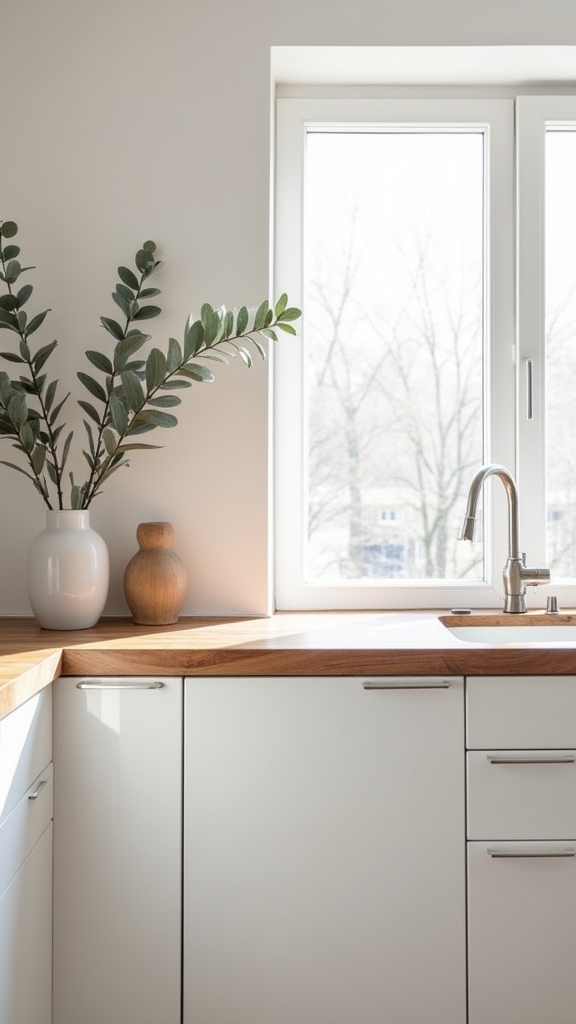
Emphasizing clean lines and functional harmony, a Scandinavian-inspired kitchen utilizes minimalist white cabinetry juxtaposed with warm timber worktops to create an inviting, streamlined environment.
The interplay of crisp white surfaces and the organic texture of warm wooden worktops defines the characteristic visual balance of this style. Expansive windows are strategically positioned to maximize natural light, intensifying the brightness of the white cabinetry while subtly accentuating the golden undertones of light wood—such as birch or beech—on the countertops.
Integrated open shelving in matching timber offers both accessible storage and curated display, reinforcing the uncluttered aesthetic. Accessories crafted from muted or natural materials, such as woven baskets or ceramic pots, are selected to complement the serene palette, further underscoring the purposeful synthesis of warmth, simplicity, and modern functionality.
Classic Shaker Cabinets and Rich Wooden Countertops
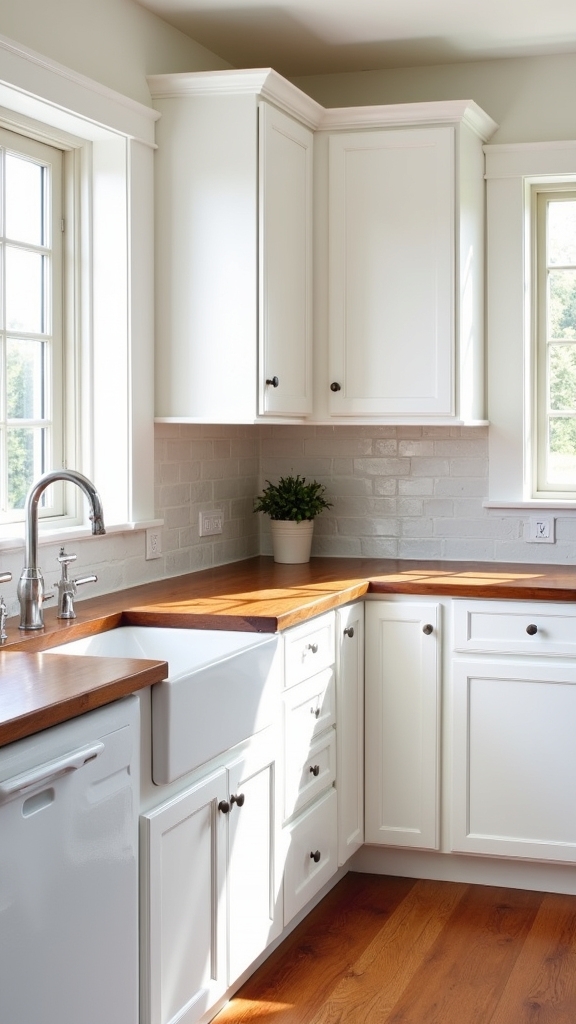
Shaker cabinetry, distinguished by its rectilinear frames and unembellished recessed panels, establishes a refined foundation for white kitchen designs.
When paired with rich wooden worktops—such as oak or walnut—the visual interplay between crisp shaker style cabinets and the organic warmth of timber generates a timeless yet inviting atmosphere.
The versatility of this pairing supports both traditional and modern aesthetics, allowing for adaptability in a range of interior schemes.
Maintenance is integral to the longevity of wooden worktops, requiring regular resealing and attentive cleaning to preserve their tactile beauty and function.
- Shaker style cabinets anchor a kitchen with understated sophistication and enduring appeal.
- Wooden worktops introduce warmth, depth, and resilient functionality to the space.
- The union of these elements guarantees a kitchen that is both practical and visually harmonious.
The modern lighting fixtures with black accents can complement the warmth of wooden worktops, adding a chic design element while maintaining a cozy atmosphere.
Boho Small Kitchen With White Units and Wooden Details
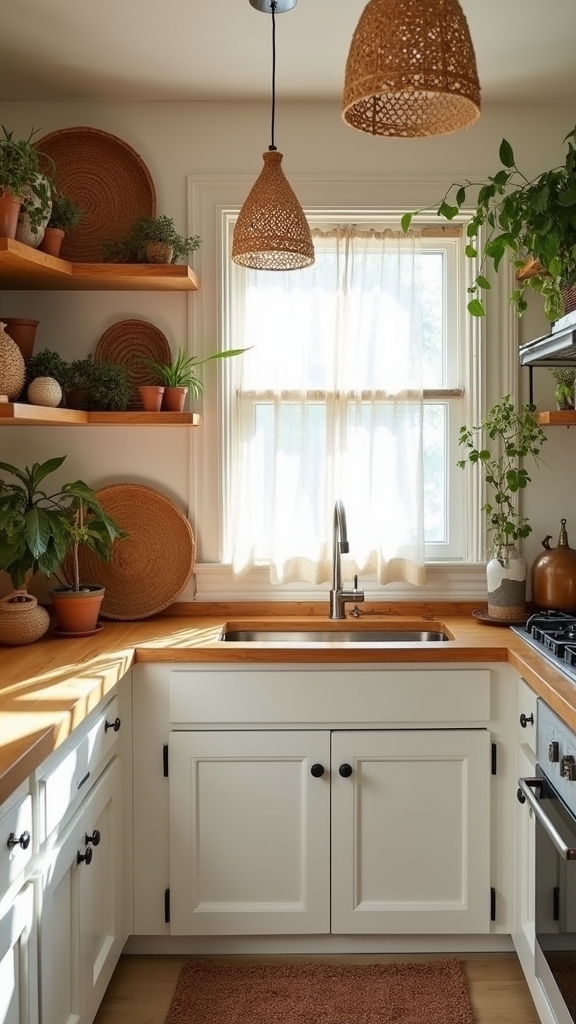
A boho small kitchen achieves spatial clarity and visual warmth through the strategic pairing of crisp white cabinetry with tactile wooden details.
This kitchen design leverages the luminosity of white units to amplify light and create an open, airy perception, essential in compact spaces.
White cabinetry brightens the space, enhancing light and openness—an invaluable strategy for making small kitchens feel spacious and inviting.
Wooden worktops introduce organic texture and contrast, enriching the visual interest while maintaining functional durability.
Open shelving crafted from reclaimed wood allows for practical storage and the display of curated accessories, reinforcing the eclectic sensibility inherent to boho aesthetics.
The juxtaposition of white gloss cabinets with rustic wooden accents strikes a harmonious balance between modern minimalism and casual, lived-in comfort.
Integrating greenery and colorful decor further personalizes the space, delivering a kitchen that is both stylish and distinctly welcoming.
Consider incorporating LED-lit shelves to enhance ambiance effectively, offering energy-efficient lighting that highlights decorative pieces and creates a modern atmosphere.
Eclectic Urban Kitchen With White Cabinets and Reclaimed Wood
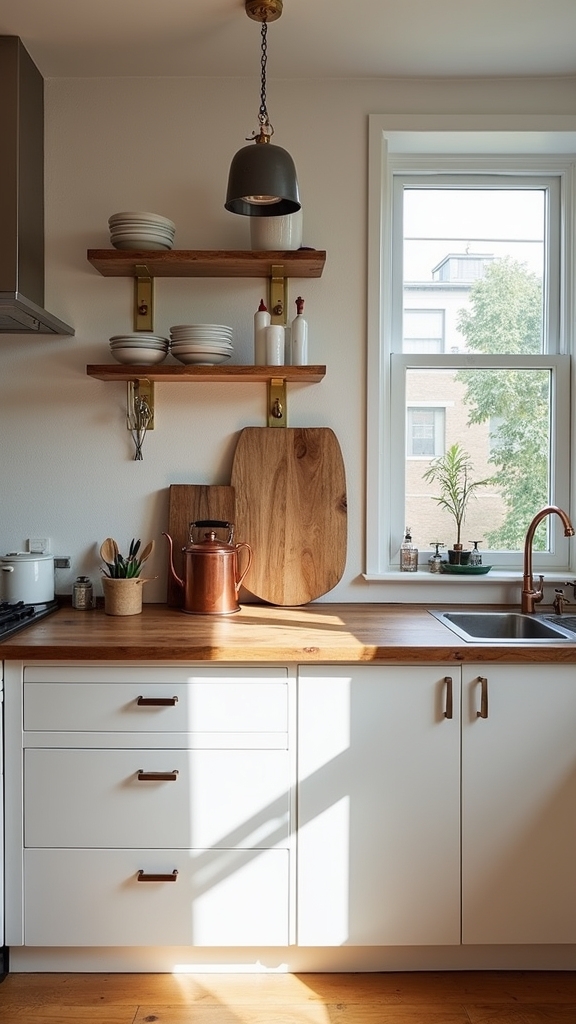
An eclectic urban kitchen employs a dynamic interplay of textures by juxtaposing sleek white cabinetry with the tactile richness of reclaimed wood surfaces. Open shelving constructed from salvaged timber introduces both functional storage and curated display opportunities, amplifying visual interest. This strategic combination supports a harmonious balance between modern minimalism and organic warmth. The integration of natural wood elements like reclaimed wood enriches the rustic vibe, adding warmth and texture to the kitchen ambiance.
Mixing Textures and Finishes
When blending white cabinetry with reclaimed wood elements, an eclectic urban kitchen achieves a harmonious balance between modern minimalism and rustic warmth.
The juxtaposition of smooth, reflective white cabinets with the tactile, organic character of reclaimed wood introduces both visual intrigue and textural depth. This strategic mix optimizes not only aesthetics but also functional resilience and longevity.
Designers frequently employ the following techniques:
- Contrast Enhancement: Crisp, glossy white cabinets paired with reclaimed wood worktops create striking contrast, emphasizing both materials’ unique qualities.
- Eco-Conscious Materiality: Utilizing reclaimed wood underscores sustainability while ensuring each surface has distinct patina and narrative.
- Layered Visual Texture: The interplay between sleek cabinetry and rugged wood introduces dimensionality, preventing visual monotony and fostering a warm, urban sophistication.
Open Shelving for Display
While emphasizing both display and accessibility, open shelving in an eclectic urban kitchen with white cabinetry and reclaimed wood introduces a dynamic interplay of form and function.
The juxtaposition of rustic reclaimed wood shelves against sleek white cabinetry crafts a visually engaging environment, balancing modern minimalism with vintage charm. Open shelving acts as a stage for curated collections—colorful dishware, unique ceramics, or glassware—injecting personality and warmth into the neutral backdrop.
The absence of upper cabinet doors visually expands the kitchen, optimizing perceived space and airiness. Functionally, open shelving streamlines workflow by granting immediate access to daily essentials.
Strategic use of decorative baskets or containers maintains organization, ensuring the display remains intentional. This approach enhances both the utility and the aesthetic cohesion of the kitchen.
Cozy Country Kitchen Featuring White and Butcher Block

Blending white cabinetry with butcher block countertops achieves a harmonious balance of brightness and warmth, fundamental to a cozy country kitchen. The juxtaposition of crisp white surfaces against the organic grain of hardwood butcher block countertops—often crafted from maple or walnut—introduces both visual texture and functional durability. This approach not only reinforces a welcoming ambiance, but also prioritizes practicality for daily meal preparation and social gatherings. To further accentuate this inviting aesthetic, experts recommend the following:
- Open shelving in reclaimed wood: Enhances rustic character and guarantees easy access to essentials.
- Vintage-inspired pendant lighting: Warms the space and highlights the natural tones of wood and cabinetry.
- Regular maintenance of butcher block: Periodic oiling preserves the countertop’s integrity and amplifies its tactile appeal.
Integrating compact appliances fit neatly into corners can enhance functionality without compromising the charm of the kitchen. This precise configuration delivers timeless charm and everyday usability.
Transitional Design With White Units and Contrasting Wood Island

A transformative kitchen anchored by white cabinetry and a contrasting wood island exemplifies the seamless integration of contemporary minimalism with classic warmth.
In this evolving design, white units establish a clean, luminous backdrop that maximizes spatial perception, while the wooden island introduces tactile richness and visual depth.
Opting for a medium to dark wood finish on the island creates a dynamic counterpoint, enhancing both the clarity of the white units and the inviting character of the wood.
The wooden island serves not only as a central prep area but also as a communal hub, supporting multifunctional use from casual dining to entertaining.
Accenting the white cabinets with brass or matte black hardware unifies the palette, delivering a polished, cohesive, and enduringly stylish kitchen environment.
Additionally, sage green works beautifully with brass or gold hardware, providing a touch of elegance that can be applied to accent elements within the kitchen.
White Kitchen With Wooden Open Shelving for Display
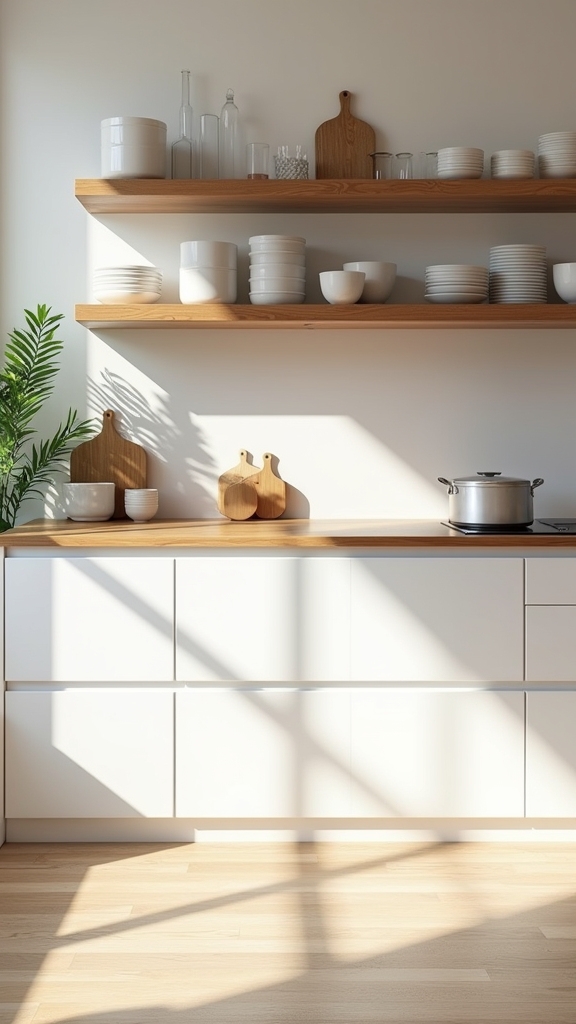
Integrating wooden open shelving into a white kitchen creates a curated platform for displaying decorative kitchenware, infusing the space with personalized artistry.
The natural timber contrasts with crisp white cabinetry, amplifying visual warmth and enhancing spatial openness.
This configuration strategically balances accessible storage with aesthetic presentation, optimizing both function and style.
Showcasing Decorative Kitchenware
While crisp white cabinetry establishes a clean and luminous backdrop, the introduction of wooden open shelving injects warmth and tactile contrast into the kitchen environment.
Open shelving serves as an architectural framework for curated kitchen decor, allowing decorative kitchenware to become both functional and visual focal points. The strategic use of reclaimed wood not only aligns with sustainable design principles but also highlights distinctive textures, juxtaposing the smoothness of white cabinetry.
- Display Versatility: Shelves accommodate an evolving collection of colorful ceramics or glassware, fostering dynamism in kitchen decor without structural changes.
- Functional Accessibility: Frequently used items remain within reach, ensuring daily efficiency while reinforcing the kitchen’s modern utilitarian ethos.
- Aesthetic Layering: Thoughtful arrangement of kitchenware introduces accent hues and organic materials, enhancing spatial depth and visual sophistication.
Enhancing Visual Warmth
Pairing white cabinetry with wooden open shelving produces an immediate sense of visual warmth, amplifying both the tactile and tonal dimensions of the kitchen.
The juxtaposition of crisp white surfaces and the organic texture of wood introduces a dynamic interplay of materials, accentuating the inherent beauty of each. In a white kitchen, this approach not only enhances the ambiance but also creates a curated platform for display—ideal for artful arrangements of dishware, plants, or decorative objects.
Opting for reclaimed wood shelving further intensifies visual warmth by introducing patina and character, which contrast elegantly against the clean, minimalist lines of contemporary cabinetry.
This synthesis of function and aesthetics elevates the overall spatial experience, ensuring the kitchen remains both inviting and visually compelling.
Balancing Storage and Style
When executed with careful consideration, the introduction of wooden open shelving to a white kitchen achieves an ideal equilibrium between storage efficiency and visual sophistication.
Open shelving balances the solid presence of kitchen cabinets, offering both accessibility and a curated aesthetic. The interplay of white cabinetry and natural wood injects warmth and depth, preventing sterility and enhancing spatial perception.
To maximize both function and style, it is essential to maintain strategic organization and minimize visual clutter.
- Curated Display: Selectively arrange dishware, glassware, and decorative accents to harmonize with the white and wood palette, elevating everyday essentials into artful vignettes.
- Spatial Lightness: Open shelving reduces the visual weight of traditional kitchen cabinets, promoting a sense of openness.
- Functional Accessibility: Frequently used items remain within easy reach, streamlining daily routines.
Light-Filled Space With White Gloss and Pale Wood Worktops
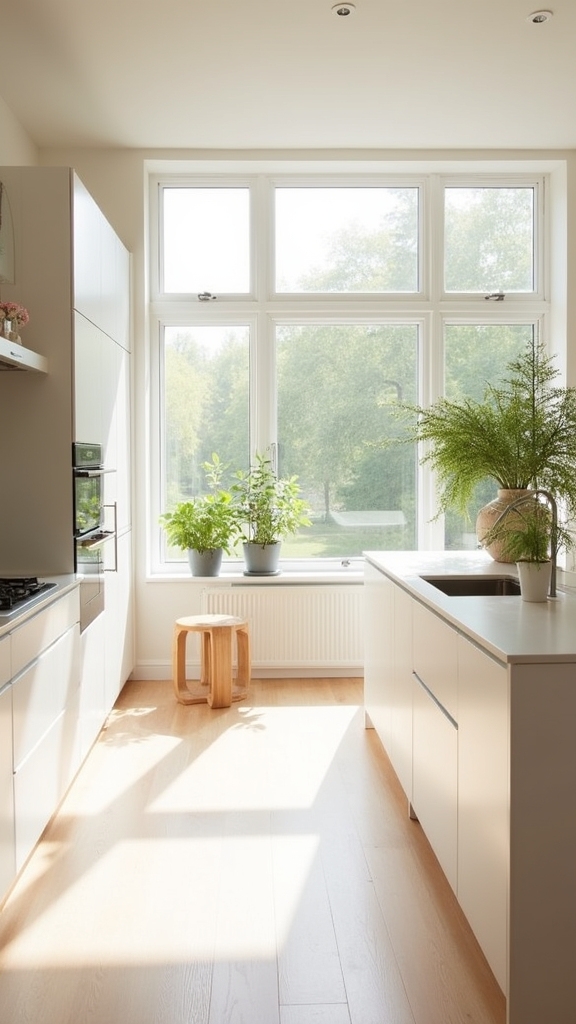
Abundant natural light transforms a kitchen with white gloss cabinetry into a visually expansive environment, as reflective surfaces amplify brightness and enhance spatial perception.
The interplay of white gloss finishes with pale wooden worktops—such as oak or ash—creates a harmonious balance between sleek modernity and organic warmth. These pale wood surfaces introduce tactile contrast and visual softness, counteracting the coolness of all-white units.
This design approach is particularly effective in compact spaces, optimizing the diffusion of daylight to deliver an open, airy ambiance while making the kitchen appear larger.
Functionally, wooden worktops provide a resilient and practical workspace, supporting everyday culinary tasks.
This versatile white and wooden combination offers adaptability, integrating seamlessly with a range of décor styles, from contemporary minimalism to understated rustic charm.
Compact Galley Kitchen With White Cabinets and Walnut
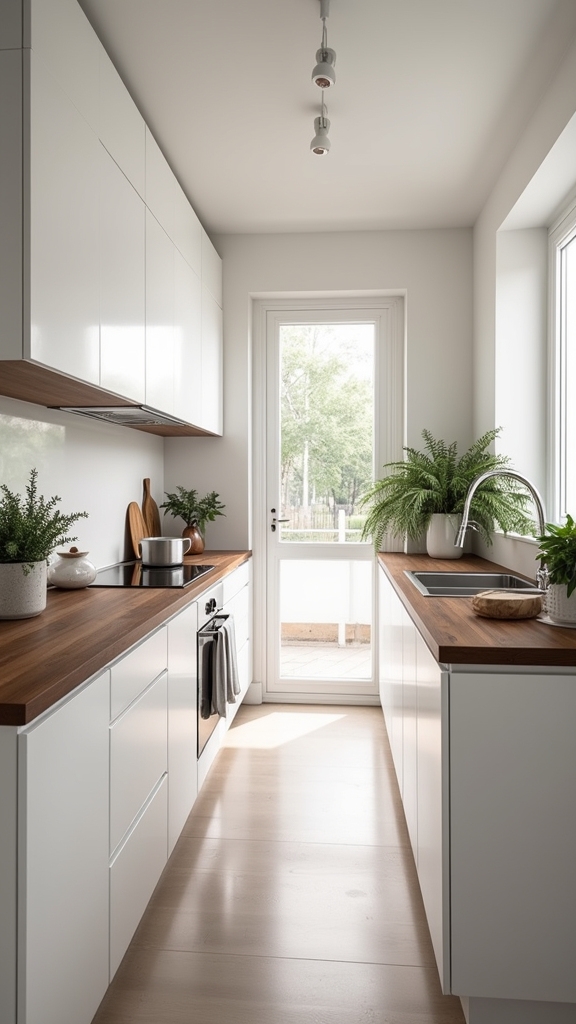
Contrast defines the aesthetic in a compact galley kitchen where crisp white cabinetry is offset by the richness of walnut worktops. The interplay of these two elements transforms confined dimensions into a visually dynamic and efficient workspace.
White cabinets reflect ambient and task lighting, optimizing spatial perception while maintaining a pristine, contemporary appeal. Walnut worktops inject warmth and tactile depth, their durability supporting daily culinary demands.
Incorporating eco-friendly materials aligns with both modern design trends and sustainable practices, enhancing the kitchen’s overall appeal.
Key considerations for this configuration include:
- Spatial Clarity: The reflective quality of white cabinets enhances openness, essential in galley settings.
- Material Durability: Walnut worktops provide robust surfaces resistant to abrasion, ideal for high-use areas.
- Integrated Storage: Open shelving combined with closed cabinetry maximizes storage without overwhelming the narrow footprint, preserving both function and elegance.
Industrial Loft Kitchen Blending White With Rustic Wood
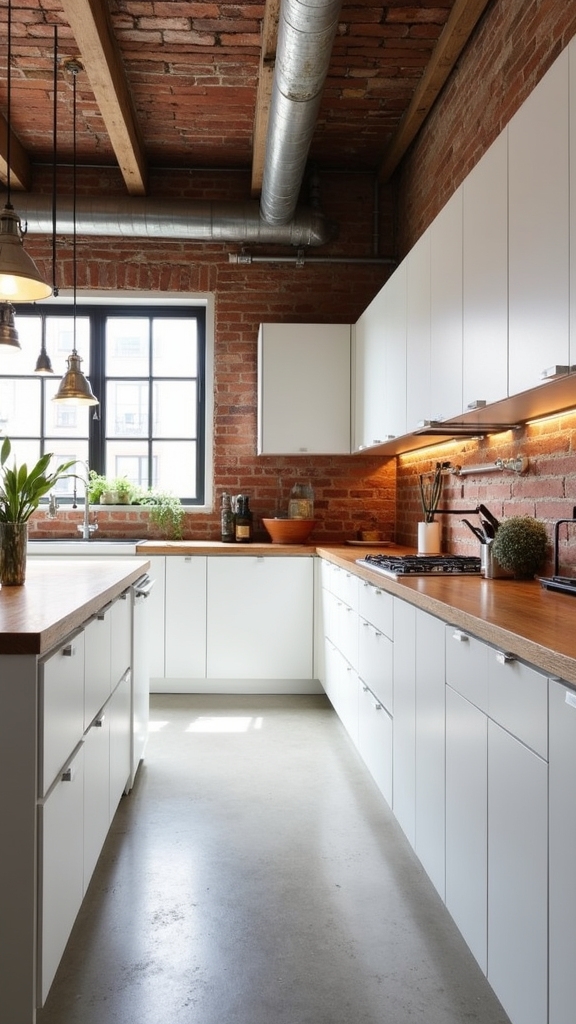
A distinctive industrial loft kitchen effortlessly merges sleek white cabinetry with the organic texture of rustic wooden worktops, achieving a harmonious balance between modern minimalism and tactile warmth. In contemporary kitchen designs, reclaimed wooden worktops introduce character and a storied patina, while high-gloss white cabinets amplify ambient light, optimizing spatial perception. Industrial elements—such as exposed ductwork and robust metal fixtures—accentuate the loft aesthetic and underscore functional intent. Open wooden shelving integrates seamlessly, offering accessible storage and display zones that celebrate curated objects. This design paradigm invites versatility: bold accessories or vibrant artwork can punctuate the white-and-wood foundation. The combination is especially effective in urban environments, delivering both visual impact and practical durability. Incorporating natural materials like reclaimed wood not only enhances warmth and texture but also aligns with eco-friendly design principles.
| Feature | Material | Functional Benefit |
|---|---|---|
| Cabinets | White gloss | Light reflection |
| Worktops | Reclaimed rustic wood | Warmth & character |
| Shelving | Exposed wood | Display & storage |
Timeless All-White Kitchen Enhanced by Oak Work Surfaces

While crisp white cabinetry establishes an atmosphere of pristine clarity, the integration of oak work surfaces injects tactile warmth and nuanced visual depth into the kitchen environment.
This juxtaposition is not only visually compelling but also exceptionally practical, as oak worktops are renowned for their resilience and adaptability. Their ability to accept diverse stains enables bespoke customization, complementing the luminous elegance of white cabinetry.
The interplay between these elements achieves a balanced aesthetic that transcends fleeting design trends, making it suitable for both modern and traditional interiors.
- Enhanced Visual Contrast: The rich grain and natural hue of oak worktops provide a sophisticated counterpoint to the stark simplicity of white cabinetry.
- Functional Versatility: Oak surfaces offer robust zones for meal prep and casual dining.
- Enduring Appeal: This pairing remains relevant across evolving interior styles.
Frequently Asked Questions
What Color Worktop Goes Best With a White Kitchen?
When selecting countertop materials for a white kitchen, contrasting shades such as rich walnut, marble alternatives like quartz, or light maple enhance visual impact. These options balance aesthetics with functionality, offering durable surfaces while emphasizing modern sophistication and warmth.
How to Make a White Kitchen Feel Warmer?
To create warmth in a white kitchen, experts recommend integrating layered lighting options and strategically placed kitchen accessories. Under-cabinet lighting, pendant fixtures, and textured decor elements enhance visual depth, while functional accessories introduce inviting color and tactile interest.
What Colour Cupboards Go With Wood Worktops?
Selecting cabinet color combinations for wood worktops relies on balancing wood tones with contrasting or complementary hues. Pale blue, sage green, deep navy, or charcoal grey cabinetry visually emphasize wood’s warmth, optimizing both aesthetic cohesion and functional versatility.
How to Make a White Kitchen Look Homey?
To make a white kitchen look homey, designers recommend layering cozy accessories, such as textured textiles and curated dishware, integrating warm lighting through pendant fixtures, and incorporating organic elements to visually soften the space and enhance user comfort.
Conclusion
A white kitchen paired with wooden worktops achieves an expert balance of visual warmth and functional elegance. The interplay between crisp cabinetry and natural timber delivers timeless appeal, whether through classic shaker doors, minimalist Scandinavian designs, or industrial accents. Each configuration maximizes light reflection, enhances spatial perception, and offers durable surfaces for everyday use. By integrating wood’s organic texture, these kitchens remain inviting while prioritizing practicality and enduring style in both modern and traditional settings.
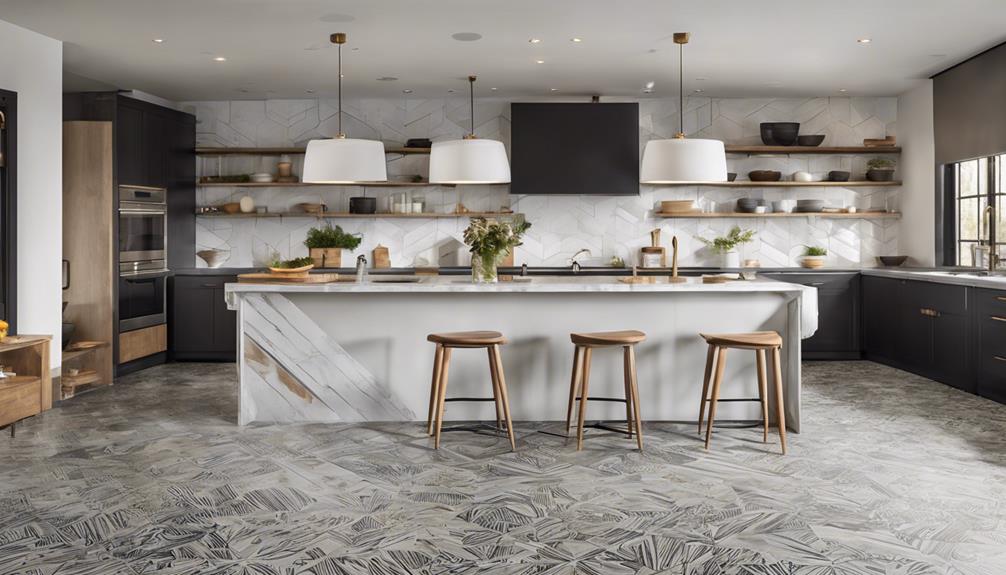
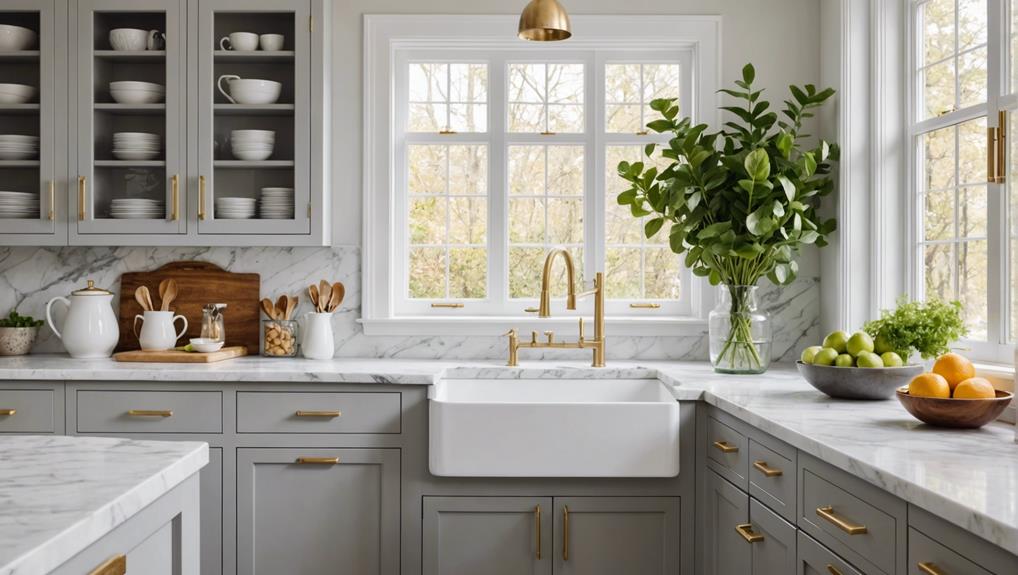
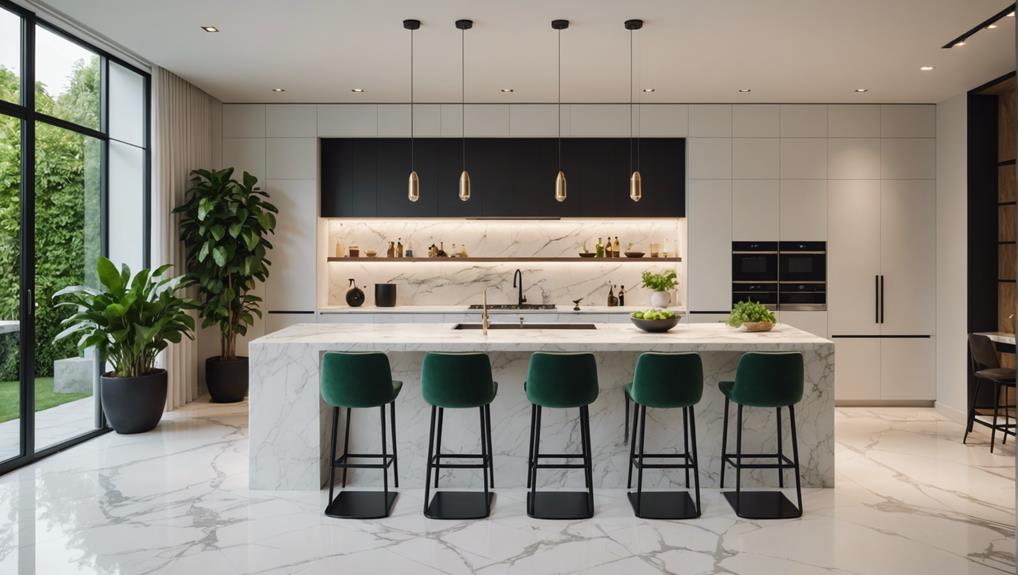
Leave a Reply